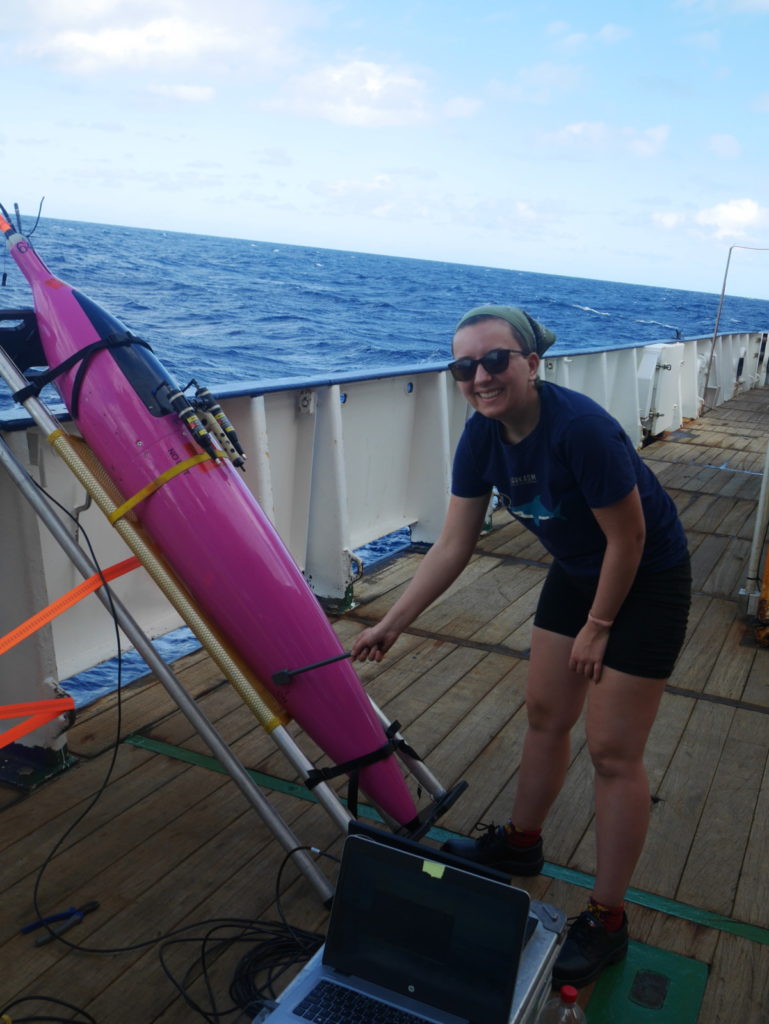
As many seagoing oceanographers find themselves on land for the foreseeable future, we’ve decided to share a tale of a research cruise to fill that ship-shaped void.
Back in January 2020, four research vessels ventured out into the Tropical North Atlantic as part of the Eurec4a and ATOMIC campaigns. Eurec4a’s aim: to investigate the couplings between clouds, circulation and convection and how these feed into climate change. Within this, vast webs of interlinking research studies were constructed. By the campaign’s end in February 2020, we had gathered data from kilometres up in the atmosphere right down to the ocean floor.
I found myself stepping aboard the German R/V Meteor in the middle of January, ready for my first experience of life at sea. Four of our six weeks aboard were spent studying an area east of Barbados between roughly 14°30’N and 12°N, dubbed ‘the tradewind alley’. Whilst much scientific focus was dedicated to the sky and cloud systems, a few groups of scientists onboard focused instead on the ocean. Collectively, we studied the biology and physics of the ocean, utilising research equipment ranging from the conventional CTD to the less conventional autonomous vehicle.
The autonomous vehicles deployed from the R/V Meteor were two Seagliders and five Argo floats, complemented by an AutoNaut and Seaglider launched from Barbados by the University of East Anglia. The AutoNaut was equipped to carry and release the Seaglider from beneath it, to preserve the Seaglider’s battery. The AutoNaut and three Seagliders teamed up over 11 days to patrol a 10×10 km box in line with the HALO aircraft’s flight circle and the R/V Meteor’s meridional transect, giving us a wealth of data in a small area. At the end of our time in tradewind alley, we recovered the 3 Seagliders to the R/V Meteor and the AutoNaut returned to Barbados under its own power.
Seaglider – A buoyancy-powered autonomous underwater vehicle which pumps oil in and out of an external bladder to vary its density, thus buoyancy. Can profile down to 1000 m depth. Argo float – A profiling float that drifts at 1000 m depth. Every 10 days it completes a cycle of sinking to 2000 m then returning to the sea surface to relay data via satellite. AutoNaut – A wave-propelled unmanned autonomous surface vessel designed to take meteorological and oceanographic measurements at the air-sea interface, piloted over the Iridium satellite network.
Whilst the Eurec4a data analysis is in its very early stages, we hope this will, in time, provide vital information to feed into oceanographic and climate system research. Personally, I hope to use this data to investigate the fluxes of heat and momentum at the air-sea interface. These fluxes will help us quantify the heat budget of the upper ocean mixed layer, which can feed into improving climate models.
Overall, the experiments conducted from the R/V Meteor and within the wider Eurec4a campaign were a great success. A huge thank you for everyone involved in making Eurec4a possible, with a special mention for the amazing crew of the R/V Meteor!
If you are interested in reading more about the Eurec4a project, see below:
- Eurec4a project blog
- Bony S, Stevens B, Ament F, Bigorre S, Chazette P, Crewell S, Delanoë J, Emanuel K, Farrell D, Flamant C, Gross S, Hirsch L, Karstensen J, Mayer B, Nuijens L, Ruppert JH, Sandu I, Siebesma P, Speich S, Szczap F, Totems J, Vogel R, Wendisch M, Wirth M (2017) EUREC4A: A Field Campaign to Elucidate the Couplings Between Clouds, Convection and Circulation. Surv Geophys. doi:10.1007/s10712-017-9428-0


E. A . Siddle
Let’s hope the world will benefit.
Pingback: Ocean Sciences | Satellite data for ocean reanalysis